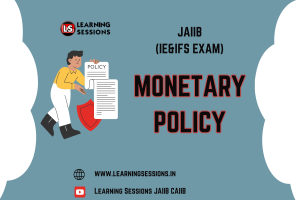Monetary Policy is an essential instrument used by central banks to manage the money supply, interest rates, and liquidity in an economy. As part of the JAIIB curriculum under the Indian Economy (IE) and Indian Financial System (IFS) modules, an in-depth comprehension of India’s monetary policy framework is key for banking professionals. The Learning Sessions’ this article on case study gives you information about the objectives, tools, and impact of monetary policy in India, with a focus on its role in controlling inflation, fostering economic growth, and maintaining financial stability.

📚 JAIIB Study Resources 📚
👉 Check Here
👉 Check Here
👉 Check Here
👉 Get Tests Here
👉 Check Here
DOWNLOAD PDF MONETARY POLICY -CASE STUDY
Monetary policy refers to the actions taken by the central bank (RBI) to regulate the money supply and control interest rates to achieve macroeconomic objectives such as controlling inflation, fostering economic growth, and ensuring financial stability. For the extensive preparation of candidates, get details through our YouTube videos for JAIIB IE & IFS Module wise Syllabus with explanations and tips to help candidates in their preparation journey.
You may also like these JAIIB Case Studies:
JAIIB | IE & IFS | LAW OF DEMAND
JAIIB | IE & IFS | ECONOMICS
Moving further, one of the few key tools of Monetary Policy are the repo rate, it is the rate at which the RBI lends short-term funds to commercial banks. Reverse Repo Rate is the rate at which the RBI borrows funds from banks. The Cash Reserve Ratio(CRR) is the percentage of a bank’s total deposits that must be maintained with the RBI in the form of reserves. The Statutory Liquidity Ratio (SLR) is the minimum percentage of a bank’s net demand and time liabilities (NDTL) that must be held in the form of liquid assets such as government securities. The RBI uses Open Market Operations (OMOs) to buy or sell government securities in the open market to regulate liquidity. The Marginal Standing Facility (MSF) allows banks to borrow funds overnight from the RBI against government securities in case of emergencies. Learning Sessions provides additional information about JAIIB IE & IFS BUSINESS CYCLE by giving examples of real life scenarios.
In conclusion, monetary policy serves as a keystone in maintaining the mild balance between economic growth and price stability in India. As explored in learning Session’ JAIIB case study, effective management of monetary policy is crucial in controlling inflation and fostering long-term economic development.
Learn more about this case study through our YouTube channel and PDF..
Get access to our Telegram Channel for free Pdfs of JAIIB.





